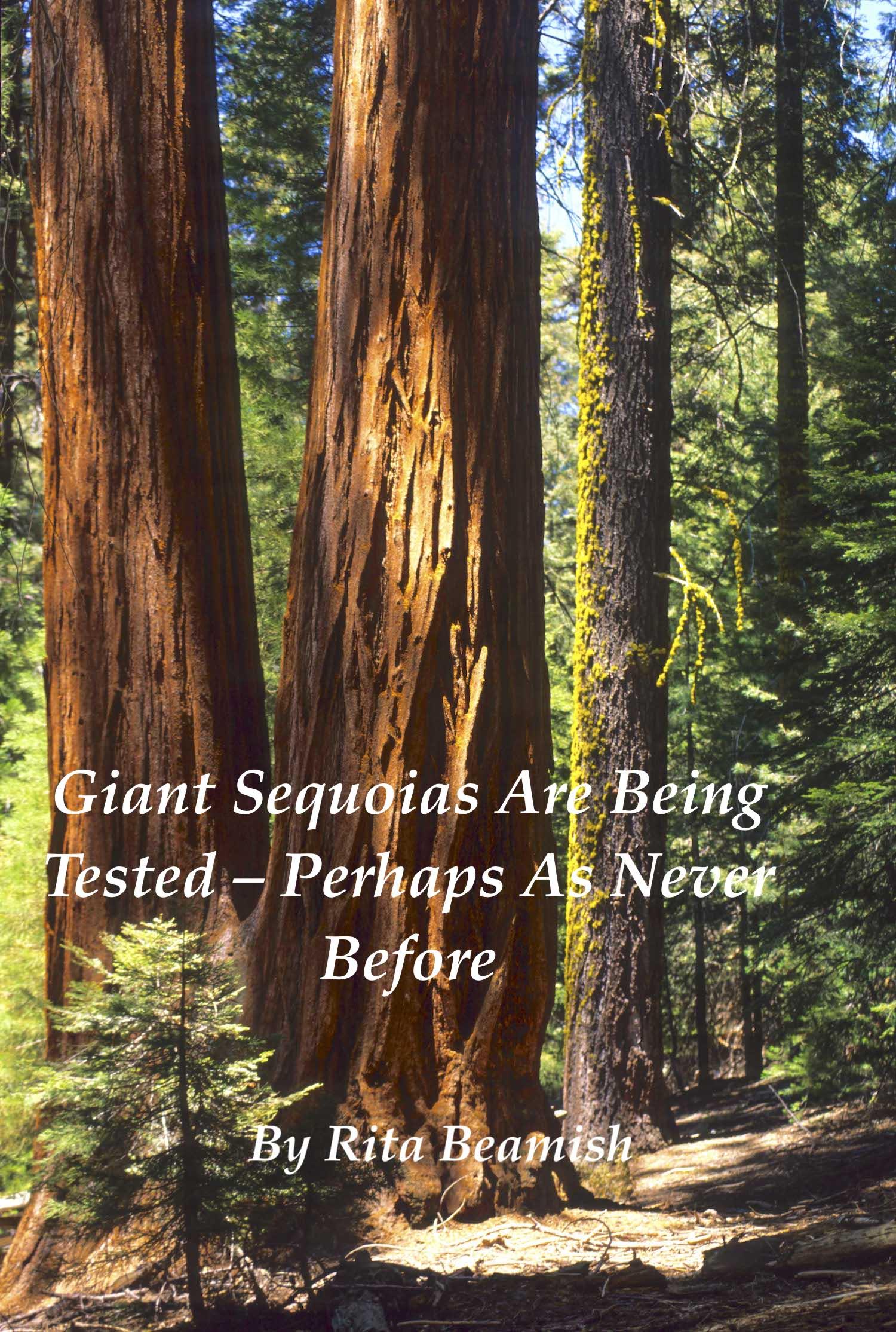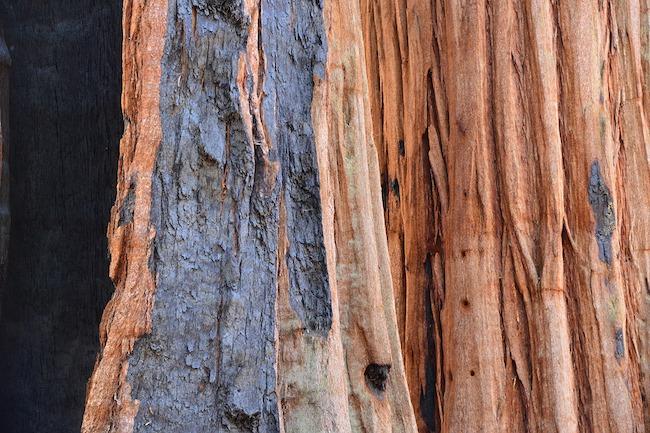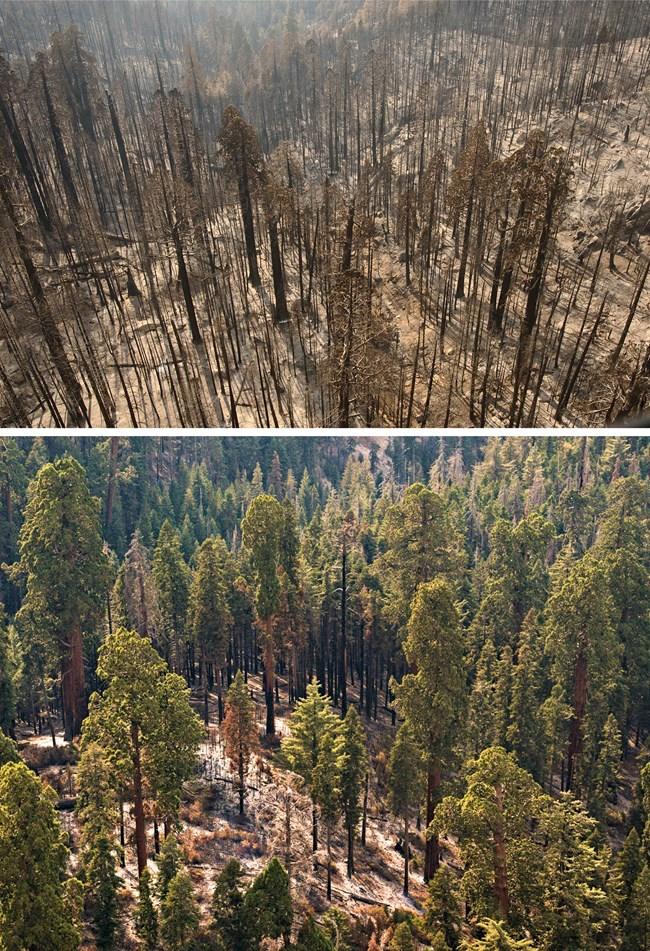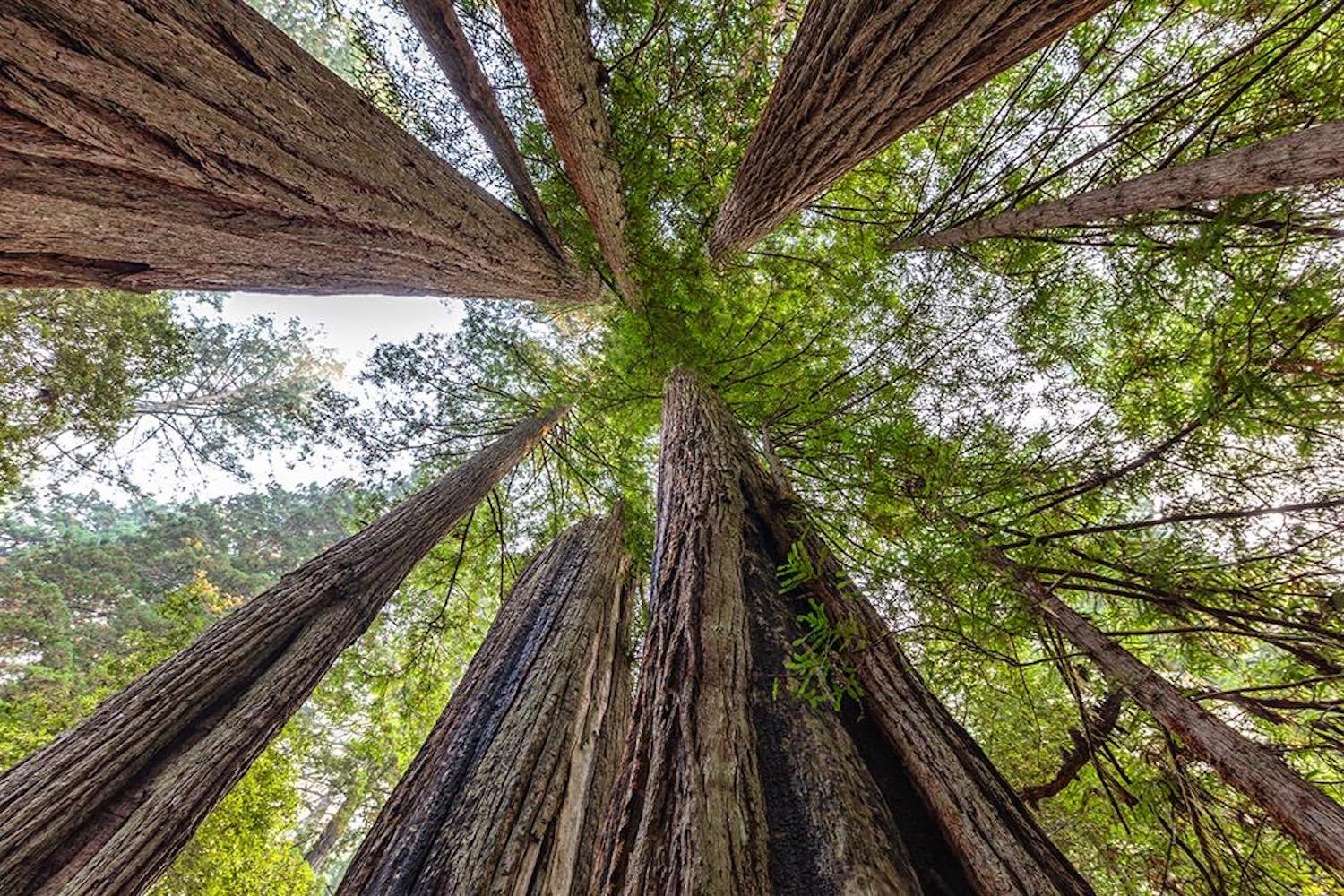
A triad of threats is attacking giant sequoias in Sequoia National Park and elsewhere in California/Patrick Cone
The biggest trees on Earth have inhabited the western slopes of California’s Sierra Nevada for millions of years. Some in the forest today were standing when the Roman Empire flourished, symbols of majesty and strength towering into the sky, resilient through centuries of wildfire, drought, and blizzards: the giant sequoias.
Today, something’s different in the groves. Yes, thousands perished in California’s record wildfires last year. That alone was unprecedented. But there’s more trouble. A trio of challenges – fire, drought, and insects - have frighteningly intersected over a few short years, leaving clues that giant sequoia history may not necessarily foreshadow the species’ future. Are these masters of the forest, with girths that can dwarf a truck, turning a corner on their ancestral journey? Experts are worried.
"I’ve never seen anything like it,” said Nathan Stephenson, a USGS research ecologist who studies climate and forests. “I think we’ve entered a new era, and it came abruptly and it surprised everybody ...
"The sequoias are facing threats they did not face even seven years ago. And those threats are probably only going to get worse,” he added, with the expected continuation of climate warming.
Government and other researchers are working to understand the extent of threat across the giant sequoia range: some 73 groves mainly stretching through national parks __ Yosemite, Sequoia, and Kings Canyon -- and Sequoia National Monument and Tahoe National Forest.
“There’s a lot of uncertainty when we try to understand the future and what we’re observing right now," said Christy Brigham, chief of resource management and science at Sequoia/Kings Canyon. Science is still trying to sort out what’s happening, she said, but “my gut level emotional response, looking at what we’ve seen in the past three years -- I am worried.”
Threats Combine
Experts cite overlapping concerns:
- Devastating wildfires have spiked since 2015, culminating in last year’s fire-season inferno. In a little over a century, from 1910 through 2014, wildfires burned 25 percent of the giant sequoia range, forest and fire ecologist Kristen Shive found when analyzing the state’s Cal Fire data. Then in 2015 through 2020, wildfires burned 65 percent of the range: 2020 alone accounted for half of that, 16,000 grove acres, dwarfing the 1910-2014 combined acreage burned.
- Giant sequoias are well adapted to drought, but drought intensified by record heat appears to have increased their stress, in varying degrees of severity depending on tree locations.
- A newly lethal cedar bark beetle is feasting on the titans. Scientists were shocked in July 2014 to observe a wave of giant sequoias dead or dying on their feet, their needles turned brown. That’s when they “woke up” to something unusual underway, said Stephenson. By 2017, they zeroed in on beetles feeding behind the thick bark as the culprit. The known death toll is at least 33 trees in 2014-19, and probably more.

The thick bark of sequoias, pictured here in a photo from Crescent Meadow in Sequoia, usually protects the trees/NPS file
The very idea that teeny insects could fell the tough, towering behemoths, was astounding. Why hadn’t their tannin content and toxic pitch repelled the beetles, as in the past, to block the deadly assault?
“We think that it’s not that cedar bark beetles have never before attacked the giant sequoia. It’s that they never before have been able to kill a standing tree, as far as the record goes,” said Brigham.
Indeed, historic scientific observations have noted the giants’ resistance to insects. Studies are continuing, but short of an iron-clad explanation, it seems the beetles have become opportunistic: They are dining in trees weakened by recent fire damage and drought, researchers believe. Those conditions may have denied them the water they use to create pitch that can keeps beetles at bay.
Earlier beetle attacks were “never more than a nuisance,” said Shive, lead forest scientist at The Nature Conservancy. “Clearly something is going on. Why are all these sequoias dying? … All of that occurred just after the peak of the drought.”
The different threats are coalescing: “Now you have the interaction of these things in a new way than they’ve experienced before. That is our best understanding.”
Deadly Conflagration
If deadly beetle forays are fairly new in giant sequoia groves, wildfire is not.
Not only have they survived ages of fires sparked by lightning or native people, but they thrive with low to moderate intensity blazes that open their cones to release seeds for regeneration. Importantly, that fire also clears out “ladder fuels,” the understory vegetation that feeds the more intense fires that can send flames climbing up to their canopies.
Though forest managers recognized after a century of fire exclusion that controlled low-intensity fire is important to forest health, vast amounts of built-up fuel remain. Smaller trees that have fallen due to drought stress increase the pile-up.
The years 2015 and 2017 brought eye-opening precursors to 2020’s devastation:
- The Rough Fire of 2015 ravaged thousands of sequoia grove acres, “most of which have not had a normal fire regime process in more than a century” due to fire exclusion, a Forest Service report noted at the time. At least 12 monarchs died in the Grant Grove of Kings Canyon National Park. Another five or six were weakened by fire and subsequently killed by beetles, Stephenson said. In other old-growth groves, partial surveys by the nonprofit Save the Redwoods League found about 70 of roughly 200 trees that were surveyed had died.
- The Pier Fire in 2017 also left blackened spires where once enormous green canopies had shielded the forest below. It claimed 54 old-growth sequoias in the Black Mountain Grove of Sequoia National Monument, a Forest Service/ Save the Redwoods inventory found. Near Yosemite, another blaze killed 39 in the Nelder Grove, roughly a third of its mature giants.

Charred but usually resilient -- the bark of a sequoia tree/Chris Sharkman via Pixabay
Then came last year’s catastrophic fire season that crisped more than 4.3 million acres of wilderness, rural areas and communities across California, the most ever recorded.
Part of that inferno was the Castle Fire, sparked by lightning in Sequoia National Forest. It took out thousands of old-growth monarchs -- a data point from satellite and aerial imagery that is most stunning when considered alongside historical losses of zero to just a few trees a year.
“All the sequoia managers I have talk to had the same reaction,” Brigham said. “To have thousands killed in a fire event is mind boggling. … These trees are incredibly fire adapted,” with fire scars in their rings to prove it.
As flames blasted through Sequoia National Park, about 3,550 acres of sequoia groves suffered high-severity burning. Park officials estimate that an unprecedented 340 monarch trees -- those with trunk diameters of four or more feet – were lost.
Thousands more succumbed in the adjacent Sequoia National Monument. In all, Castle Fire flames that were high-severity, meaning fatal to trees, burned an estimated 6,000 grove acres, Shive’s analysis found.
“What really kills a sequoia is the complete consumption of their crown," she said. “Not only were they singed -- many were completely consumed; there’s no needles left. They’re so tall and huge – up until 2015 we didn’t think that would even happen.”
Scientists suspect more than fire alone was implicated. The worst drought on record, in a state whose history is replete with drought, has teamed up with climate-change-era higher temperatures to worsen the effects of the lack of rainfall and render the trees more susceptible, they say.

The upper photo shows a portion of the Homer's Nose Grove where the fire burned with high severity, killing many trees. The lower photo is a portion of the Garfield Grove showing low fire severity - most trees still have green crowns and just some small trees and shrubs are scorched. NPS / Anthony Caprio (taken on a November 2, 2020 aerial survey by helicopter)
Adaptive Sequoias
It was drought year 2014 when giant sequoias for the first time were observed shedding exceptionally large amounts of foliage, well beyond a typical amount in any given year, according to research by Stephenson and USGS and National Park Service colleagues. That response was seen as the trees’ attempt to conserve their “hydraulic integrity,” to lessen drought stress by conserving the massive amounts of water they transport up into their canopies. The giants can suck up to 800 gallons a day in summer. Dropping foliage seemed a good, if desperate, adaption to cope with drought conditions.
But other observations noted the interconnectivity of the trees’ environment. The baking drought followed a modest prescribed fire in 2012: “While sequoias can under most circumstances heal basal fire scars and rebuild their water-conducting capacity over a period of years, the 2012 fire was immediately followed by the two most severe drought years in at least the preceding 120 years. It thus seems likely that the sequence of a fire immediately followed by extreme drought interacted to weaken the trees which then became susceptible to entry by Phloeosinus” beetle species, according to a paper by Stephenson summarizing ongoing observations.
Hot temperatures made drought effects more severe. Thirst-starved vegetation fueled flames into furious intensity. Fire-weakened trees were newly sensitive to beetles. Last year may have been a turning point, Shive said. “The stressors that have come together to get us where we are have been growing gradually, a combination of fire exclusion and fuel build up and the warming. They have been feeding off each other.”
“Since 2015, the term ‘unprecedented’ has been used year over year as conditions have worsened, and the operational reality of a changing climate sets in,” Cal Fire reported in its Siege of 2020 report. “Only the 'Big Burn' of 1910 stands in grim comparison” to last year’s brutal California fire season.
New Realities
Cities all over California last year tasted smoke from distant and nearby wildfires, including on the astonishingly apocalyptic day that the sky turned a shimmery golden orange in the San Francisco Bay Area. Attention turned to the health of the forests.
California Gov. Gavin Newsom this past week signed off on spending of more than half a billion dollars to brace the state for fire season as it heads into its driest and most fire-prone months with precipitation in some regions 50 percent lower than averages for this time of year. Newsom and lawmakers characterized the action as urgent. The governor called the money an early-action “down payment” to “get the ball rolling” toward further resiliency spending. Millions are targeted for forest projects on public and private land, including vegetation thinning projects.
Save the Redwoods League President Sam Hodder said forest management should prioritize giant sequoia groves. Noting the massive costs and human capital involved in fighting increasingly intense wildfires, he wrote in a recent Los Angeles Times opinion piece, “Treating the giant sequoia groves with prescribed fire would cost a fraction of that and result in far better outcomes.”
“We’re all patently aware of the tremendous impact of the exclusion of fire from those groves for almost a century,” said the League’s chief program officer Paul Ringgold.
Mike Theune, fire information officer at Sequoia and Kings Canyon national parks, also stressed the economic sense of preemptive efforts over firefighting costs. The need for prescribed fire and mechanical fuel thinning is about 30,000 acres a year in Sequoia/Kings Canyon, Theune said. But this year’s planned projects total about 10 percent of that. It’s just slightly more than last year’s planned projects; and those were mostly put off due to COVID-19 safety concerns and the need to fight wildfires that came early: The “fire season” is getting closer to a “fire year,” say fire managers.
Money is not the only answer, said Theune. Besides securing public buy-in for preventive burns, scaling up for what’s needed means recruiting and training crews for prescribed burns and mechanical thinning. “You need to build that workforce,” he said. “For so long we were so hyperfocused on suppression only, so our crews got really good at full-supression firefighting.”
Preventive work, begun in the parks in the 1960s, entails different skills.
The giant sequoias have shown their mettle across the ages, emerging from onslaughts time and again, sturdy and resilient, to invite a dance of sunlight through their massive canopies.
The past few years have exposed a new reality: To get through the extraordinary challenges that confront them in the 21st century, they made need the corrective actions of humans.

Coastal redwoods are somewhat more resilient to fire than are sequoias/Rebecca Latson file
Coast Redwoods Fight On
By Rita Beamish
Coast redwoods, cousins to the giant sequoias, are also massive California natives, and also suffered severe burning during California’s over-the-top 2020 wildfires. But the aftermath and the outlook for the two species is different.
While giant sequoias are the world’s biggest trees by volume, coast redwoods are the real skyscrapers, their deep red trunks looming straight up, as high as 350 feet above the forest floor -- the tallest trees on earth. They grow in fragmented forests along a 450-mile coastal band, as far south as Big Sur and north into Oregon -- including in Northern California’s Redwood National and State parks. A majority of the forest acreage is in private ownership.
In mid-August, the CZU Complex fires lit up the forest in Big Basin State Park and the Santa Cruz Mountains, an hour south of San Francisco. Around 60,000 Santa Cruz County residents were evacuated, and nearly 1,000 homes destroyed before the flames sputtered to sizzle, and then just wisps of smoke, after burning for weeks.
The fire left blackened stumps and redwood skeletons standing in piles of ash across the coastal hills.
“To the lay person it would have been assumed they were completely dead," said Paul Ringgold, chief program officer of Save the Redwoods League.

Grove of the Titans in Redwoods National and State Parks/Max Forster, Redwood Parks Conservancy
But just weeks after the fire swept through, people who ventured back witnessed something else, something “green and sprouting,” said Ringgold, “millions of sprouts coming from the trunks and branches.”
Unlike a giant sequoia, which is dead when its canopy is totally crisped, coast redwoods are able to sprout from their trunks, stumps and roots.
“The coast redwood is incredible in its capacity to respond,” said Ringgold. “If the fire is intense enough and burns the cambium, the tree above the ground will die. But it will resprout from the base. … Sequoia seedlings on the other hand are fragile and in repeat drought years have a potential of not surviving.”
Though the two big-tree species are related, the sequoias live in a drier environment, and it’s “really a tale of two forests,” said Kristen Shive, lead forest scientist at The Nature Conservancy.
That’s not to say Redwoods don’t have their own challenges, including logging history that left only 5 percent of the old-growth forest standing today, according to Save the Redwoods. Most of the range is comparatively young redwoods. Many other species are already struggling in redwood forests due to climate change.
An important role of coast redwoods is storing carbon that otherwise would be part of greenhouse gases in the atmosphere worsening global warming. Second-growth forests store less carbon than old growth trees, because the old-growth forests have more biomass and grow it more quickly. Nonetheless researchers find that the younger trees grow fast and also play an important role in carbon sequestration.
The shift from natural, beneficial fires to severe, scorched-earth blazes also creates openings for new pathogens and invasive species. “It is the combination of stressors across the redwood ecosystem that poses the greatest threat to sustaining coast redwood forests for future generations,” scientists stated in the 2018 State of the Redwoods Conservation Report from the League.
Major concerns for the coast redwood range are forest structure changes stemming from intense wildfires, said Ringgold. That includes habitat loss and threats to species that are protected by the towering trees, like the marbled murrelet. The seabird nests in Douglas firs, a conifer found next to coast redwoods.
“Just because the coast redwoods don’t necessarily die in those fires, doesn’t mean there’s not habitat impact more broadly,” said Ringgold. “What won’t recover for hundreds of years is the structure. It’s very difficult to reestablish. And may never recover.”
The larger the fire, the more chances there are for changing the overall landscape and species composition, he said. Invasive grasses, thistles and other plants, including those that are more conducive to spreading the next fire, are more likely to gain terrain after wildfires strip the ground.
Studies find the redwoods at the northern end of the range actually increasing their biomass as climate warms. At the southern end of the range, in the area near Big Sur, climate is getting drier and hotter. There’s more concern among experts about the long-term health of redwoods there that are struggling at the edge of the range.
Support National Parks Traveler
National Parks Traveler is a small, editorially independent 501(c)(3) nonprofit media organization. The Traveler is not part of the federal government nor a corporate subsidiary. Your support helps ensure the Traveler's news and feature coverage of national parks and protected areas endures.
EIN: 26-2378789
A copy of National Parks Traveler's financial statements may be obtained by sending a stamped, self-addressed envelope to: National Parks Traveler, P.O. Box 980452, Park City, Utah 84098. National Parks Traveler was formed in the state of Utah for the purpose of informing and educating about national parks and protected areas.
Residents of the following states may obtain a copy of our financial and additional information as stated below:
- Florida: A COPY OF THE OFFICIAL REGISTRATION AND FINANCIAL INFORMATION FOR NATIONAL PARKS TRAVELER, (REGISTRATION NO. CH 51659), MAY BE OBTAINED FROM THE DIVISION OF CONSUMER SERVICES BY CALLING 800-435-7352 OR VISITING THEIR WEBSITE WWW.FRESHFROMFLORIDA.COM. REGISTRATION DOES NOT IMPLY ENDORSEMENT, APPROVAL, OR RECOMMENDATION BY THE STATE.
- Georgia: A full and fair description of the programs and financial statement summary of National Parks Traveler is available upon request at the office and phone number indicated above.
- Maryland: Documents and information submitted under the Maryland Solicitations Act are also available, for the cost of postage and copies, from the Secretary of State, State House, Annapolis, MD 21401 (410-974-5534).
- North Carolina: Financial information about this organization and a copy of its license are available from the State Solicitation Licensing Branch at 888-830-4989 or 919-807-2214. The license is not an endorsement by the State.
- Pennsylvania: The official registration and financial information of National Parks Traveler may be obtained from the Pennsylvania Department of State by calling 800-732-0999. Registration does not imply endorsement.
- Virginia: Financial statements are available from the Virginia Department of Agriculture and Consumer Services, 102 Governor Street, Richmond, Virginia 23219.
- Washington: National Parks Traveler is registered with Washington State’s Charities Program as required by law and additional information is available by calling 800-332-4483 or visiting www.sos.wa.gov/charities, or on file at Charities Division, Office of the Secretary of State, State of Washington, Olympia, WA 98504.

Comments
Might I recommend these trees be tested for aluminum powder and other chemicals that do not occure naturally in the environment. I've seen reports of spreying in this area that would lead me to conclude this might be starting the dying process.